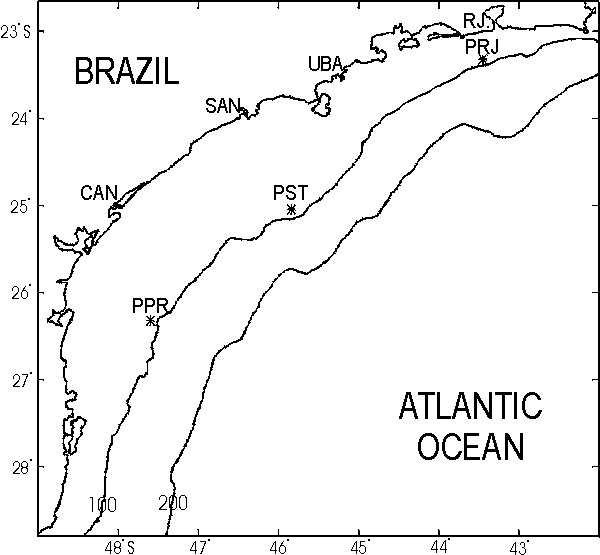
Afranio Rubens de Mesquita & Joseph Harari
Instituto Oceanográfico da Universidade de São Paulo,
Brazil
Introduction
During 1976-1981 the N/Oc. "Prof. W. Besnard", from the University of São Paulo, Brazil, under the research project named "Hidrodinâmica Costeira", (Coastal Hydrodynamics) funded by the "Financiadora de Estudos e Projetos" - FINEP, of the Brazilian Presidency of Republic, took several time series of oceanographic and meteorological variables in the Southern Coast of the Brazilian Shelf, (Fig. 1).

Fig. 1. Southeastern Brazilian shelf.
Several cruises - were planned to measure pelagic tides, currents, temperature, salinity, wind (force and direction), air temperature and atmospheric pressure. (Table 1).
Preliminary results were given in the Cruise Reports by Mesquita et al. (1976a, 1976b and 1977). Mesquita et al. (1979) contributed the project "Hidrodinâmica Costeira", on the general circulation and the occurrence of shelf break upwelling in the area; Leite (1983), studied the winds and circulation of the Cabo Frio upwelling region; Harari. (1977, 1984, 1991), analysed the circulation , tides and the induced storm surges, via a three-dimensional numerical model; Mesquita & Harari (1983), described the main aspects of the coastal tides of the area; Franco & Mesquita (1981), Mesquita & Leite (1986) examined the sea level daily, seasonal and long term variability and general accounts of the above results are presented in Mesquita (1983 and 1994).
The general circulation of the area (PST, Santos Platform, PPR, Paranaguá
Platform, and PRJ, Rio de Janeiro Platform) was object of study and
estimation via the distribution of temperature, salinity and density (Emilson,
1961) and Mesquita et al. (op. cit.), where a general overview of currents
surface distribution on the shelf can be found. First direct measurement
of currents were made by Johannessen (1968) with Eckman currentmeters,
in four fixed stations along the continental Shelf, for short periods (2
days time series), on board the N/Oc. Alm. Saldanha from the Brazilian
Navy. First account on propagation of tidal heights was given by Hutnance
(1980), who interpreted the world's highest values of the M3 that occurs
in the area, as a local resonant effect caused by the extension of the
shelf. This account describes the propagation the principal constituents
of tides and, via a rotary spectra, the tidal currents of the
shelf.
| Station Name | Plataforma de Santos | Plataforma do Rio de Janeiro | Plataforma do Paraná |
Plataforma de Paranaguá |
| Latitude (S) | 25º 1,0' | 23º 23,0' | 26º 7,4' | 26º 18,1' |
| Longitude (W) | 45º 42,0' | 43º 17,0' | 47º 39,4' | 47º 30,4' |
| Depht (m) | 92 | 100 | 60 | 74 |
| Beginning and end times of the tidal record |
22/07/1977 12:00 to 04/08/1977 10:15 (GMT) |
21/07/1978 12:30 to 21/08/1978 18:15 (GMT) | - | 18/06/1981 07:53 to 17/07/1981 07:38 (GMT) |
| Extension of the tidal record (days) | 12,9 | 31 | 29,0 | |
| Sampling interval (min) | 15 | 15 | 15 | |
| Beginning and end times of the current meter observations | 21/07/1977 22:00 to 03/08/1977 02:00 (GMT) |
22/07/1978 2:00 to 3/08/1978 15:00 (GMT) |
29/11/1980 12:30 to 12/12/1980 09:30 (GMT) | - |
|
Extension of the current meter observations (days) |
12,3 | 13 | 12,9 | |
| Sampling interval (hours) | 4 | 1 | 1 | |
|
Current meter Sampling depths (m) |
05, 15, 30, 40 | 00-10, 20-30, 40-50, 60-70, 80-90 | 05-10, 20-30, 40-50 |
Table 1. Programe of measurements.
Material and methods
The dates of the cruises along the years and the characteristics of the time series of Pelagic Tides and currents obtained are shown in Table 1. Pelagic measurement of tides were firstly taken by means of an AANDERAA gauge fixed in a ballast frame connected to a surface buoy in the Shelf of Santos. (25(01'S ; 45(42'W ), Mesquita et al. (1976a). They produced a 12.9 days record of good tidal sea level pressure data, while the second deployment of the same equipment in the Rio de Janeiro Shelf (at 23(S; 43(17'W) produced a 31 days record. (Mesquita et al., 1976b). Next deployment at the Platform of Paranaguá (26(18'S ; 47(30' W) was made in 1981, by means of the MARK I tide gauge obtained from POL (Proudman Oceanographic Laboratory) - Bidston, UK - that tide gauge operates on acoustic signals for deployment and the release of the pressure gauges and the recording system from the ballast frame. (Spencer & Gwiliam, 1974). A 29 days of good tidal record were produced.
Pelagic measurement of tidal heights at the "Platform of Santos"- PST position - were taken at the maximum bottom depth of 92 m, at the "Platform of Rio de Janeiro" - PRJ - at 90 m and at the "Platform of Paraná" - PPR - at 60m depth. Four hourly measurement of currents were taken by anchoring the N/Oc. "Prof. W. Besnard" at depths of 100 m in the PST (Santos) and hourly measurement at PRJ (Rio de Janeiro) Shelf, by anchoring at 103m and at 60 m in the PPR (Paranaguá) Shelf, during periods of 13 to 14 days at every 10 m interval down to the bottom; (except at PST, that reached only 40 m depth). Measurements of currents, listed in Table 1, were taken with the English Braystocke direct reading meters (PST) and the Brazilian, Palm meter of the Hidrologia/Hidrocean (PRJ) and CONSUB (PPR), Brazilian manufacturers. The efforts in PPR were more accurate, lengthier and more extensive. Braystocke direct reading currentmeters, from UK, were used "over the side" deployments in the PST measurement; Hidrocean direct reading currentmeters, from Brazil, were used in the PRJ measurement and the CONSUB direct reading meters, from Brazil, in the PPR. The duration of each reading varied from 5 minutes with the Braystockes to 2 minutes with the CONSUB meters. All currentmeters were previously calibrated at the testing tank of the "Instituto de Pesquisas Tecnológicas" - (IPT) - University of São Paulo, (Mesquita, 1983 and Mesquita et al., 1989).
The analysis of tidal data were made via the Harmonic Method (Franco & Rock, 1971) and the Response Method ( Munk & Cartwright, 1966).
Figure 2 gives the tidal constants of the tidal heights for the permanent stations of the main ports of the area, such as Rio de Janeiro, Ubatuba, Santos, Cananeia, Paranaguá, which are nominated respective. PRG, CAN, SAN & UBA. The Pelagic non-permanent stations on the Continental Shelf were nominated as PRJ, (Platform of Rio de Janeiro), PST (Platform of Santos), PPR (Platform of Paranaguá), and PSC (Platform of Santa Catarina). Results for the Pelagic tidal constants are also reported in IAPSO'S Committee Report n0 2, Cartwright & Zetler, (1985) and Smithson, (1992).;.The clockwise and anticlockwise rotary spectra of currents, Figures 3a, 3b and 3c, were estimated by Fourier transforming the smoothed auto-covariance of currents components according to Jenkins & Watts (1968), following Gonela (1972), for the interpretation of the rotary spectra.
Results
A - The coastal and shelf tidal heights
The South -Eastern Coast of the Brazilian Shelf area is shown in Figure 1 with the mapped locations of the ports, where there are permanent stations of tidal observations and the pelagic sites on the Shelf. In Figure 2 are plotted the values of Tidal Constants of the main tidal heights constituents determined for the ports of Rio de Janeiro, Santos, Cananéia, Paranaguá, and Imbituba and the PRJ, PST, PPR and PSC geographical positions shown in Figure 1. Inspection of phases of Figure 2 shows that semidiurnal heights constituents M2, N2 , K2, and S2 have an anticlockwise propagation from PRJ to PST and a clockwise one between PRJ and PST. Their amplitudes show a general increase from East to West, being higher near the port of Paranaguá. Among the diurnal (Table 2), the Q1 and O1, , propagate from IMB to RJA in a West to East clockwise propagation, while K1 and P1 propagation follow approximately the semidiurnal components M2, S2, N2, K2 and have also higher amplitudes near Paranaguá/Cananéia and propagate clockwise from IMB and PSC to PPR and anti-clockwise from Rio to Paranaguá. Such opposite senses of propagation also suggest that the K1 has two amphidrome in the South Atlantic, one propagating clockwise and the other anticlockwise. The M3 have higher amplitudes , as the semidiurnal, along the Paranaguá Shelf . The phases of M3 in the area are not so elucidative , as do as well, any interpretation of the propagation behaviour of higher order components such as M4, MS4 and others given in Figure 2.
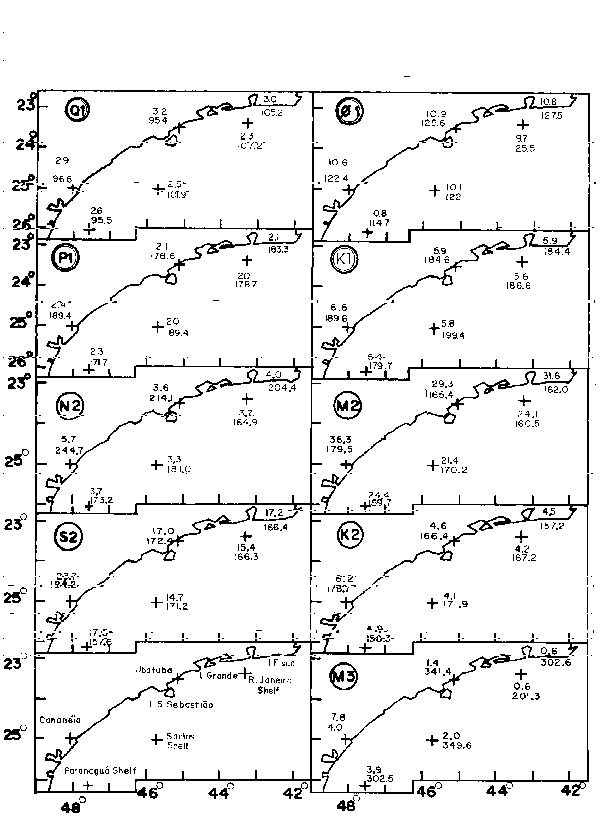
Fig. 2. Amplitudes and phases of tidal currents of Brazilian Southeastern
Shelf.
B - The shelf tidal bands of currents
The circulation rotary spectra of all sites have as common features the long term band variability and the diurnal , semidiurnal , Ter-diurnal , fourth-diurnal tidal bands. The amplitudes of each band were determined with a 95 % interval confidence for PPR (Fig. 3a) and PST, (Fig. 3b) and with 80 % confidence interval for PRJ (Fig. 3c). The long term band circulation (3 to 5 days), better seen in PST spectra, is mainly an anticlockwise circulation band and is due to the atmospheric forcing over the area (Mesquita et al., 1977). All the other circulation bands of the Figure 3 are, in general, tidal anticlockwise bands, but the ter- diurnal band in PPR, that has a clockwise rotation opposed to the counter-clockwise propagation of the M3 heights. The vertical distribution of the diurnal circulation band of PPR shows a prominent counter-clockwise rotation that includes the inertial period for the area (27 h) at the surface (5 m). The band amplitude diminishes and is non existent at the bottom layer of the column (60 m). This is also true for the PRJ shelf, where the diurnal band is well defined at the surface (5 m) but has, in the bottom layer (90 m), a not clear signature, so that, is difficult to identify a significant peak in the band spectra with clock or counter-clockwise circulation. The distribution of the semidiurnal circulation bands of PPR shows strong counter-clockwise values from the surface layer (5 m) to the bottom, (60 m), with a stronger contribution to the total spectra of the clockwise amplitude at the mid to the bottom layer. In the PST the semidiurnal circulation band is prominent keeping the counter-clockwise rotation at (5 m) and (40 m) depths and in PRJ, it is almost non existent, either with clockwise or counter-clockwise rotation, from surface (5 m) to the bottom (90 m) layers. The Ter-diurnal circulation band is determined in PPR with a clockwise rotation, which decreases in amplitude along the column. It can not be detected significantly in PST, but appears in the circulation counter-clockwise spectra of PRJ all along the column from surface to the bottom. The fourth diurnal counter-clockwise circulation band also occurs, although with lesser statistical significance than the major bands The fourth-diurnal circulation band is evident in PPR at the surface layer, with a dominant counter-clockwise rotation, which turns to be equally important to the clockwise rotation at mid depth and with clockwise and counter-clockwise circulation bands slightly displaced at the bottom layer. At the surface layer of PRJ, the fourth-diurnal band does not seem to have a predominant rotation; it seems to be counter-clockwise at mid depths and is mainly clockwise at the bottom layer.
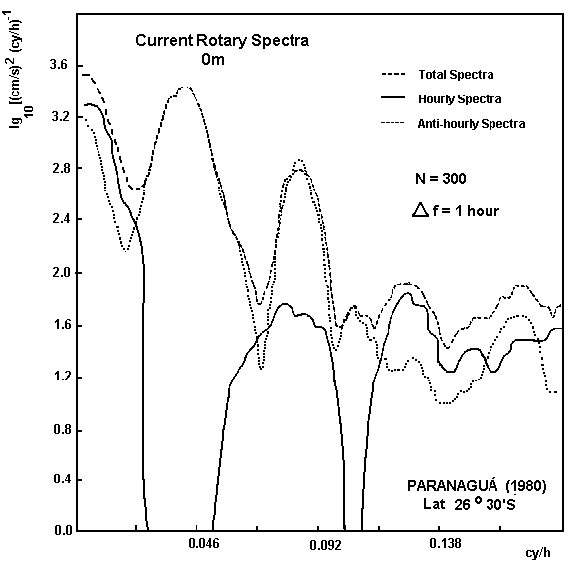
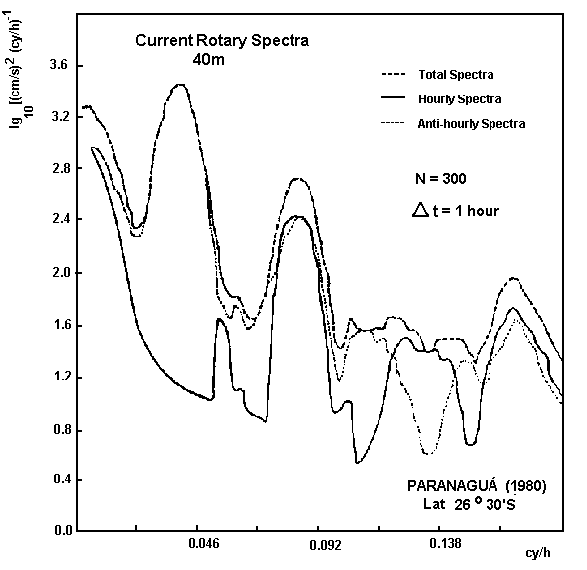
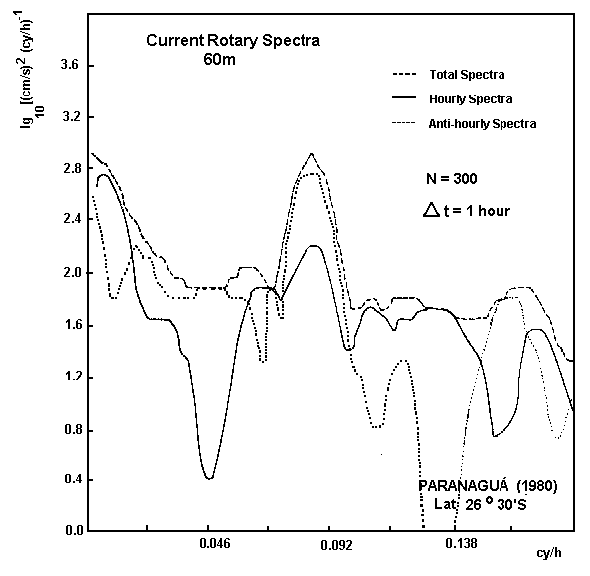
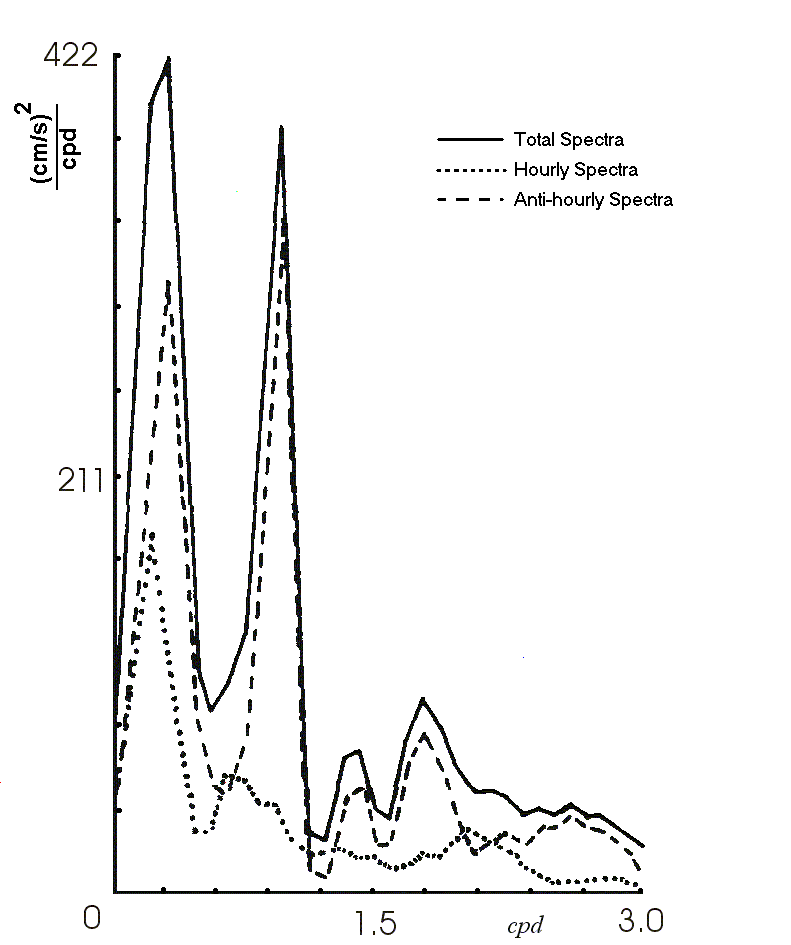
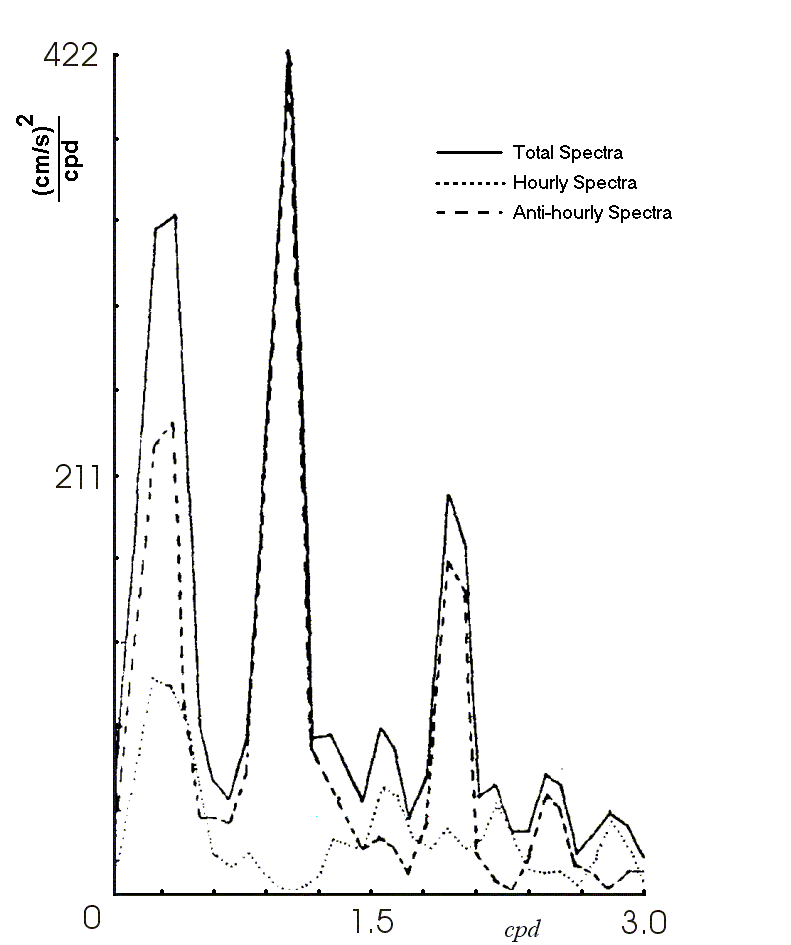
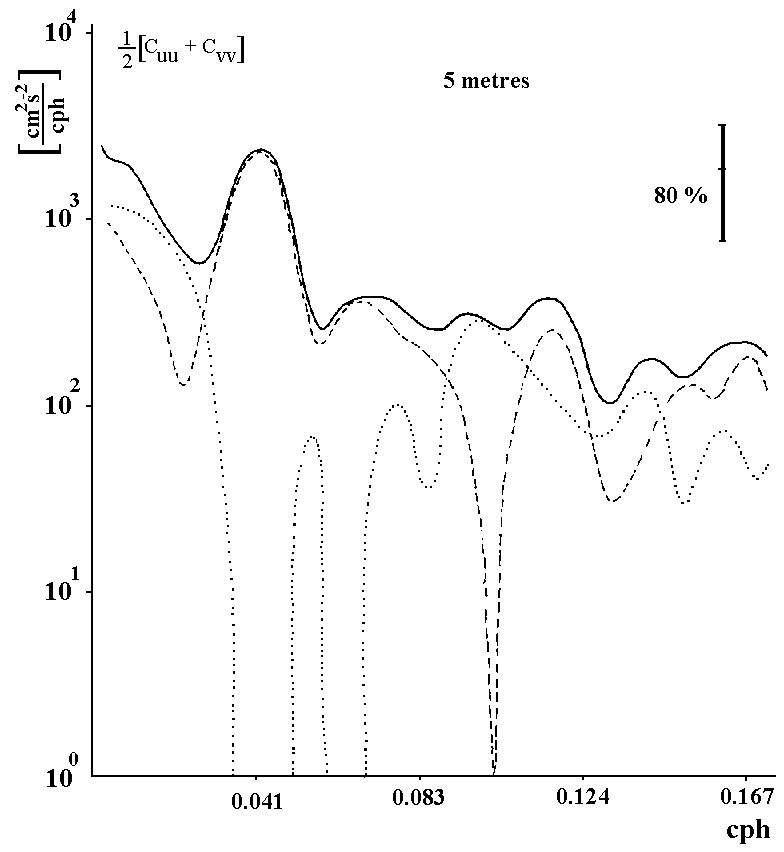
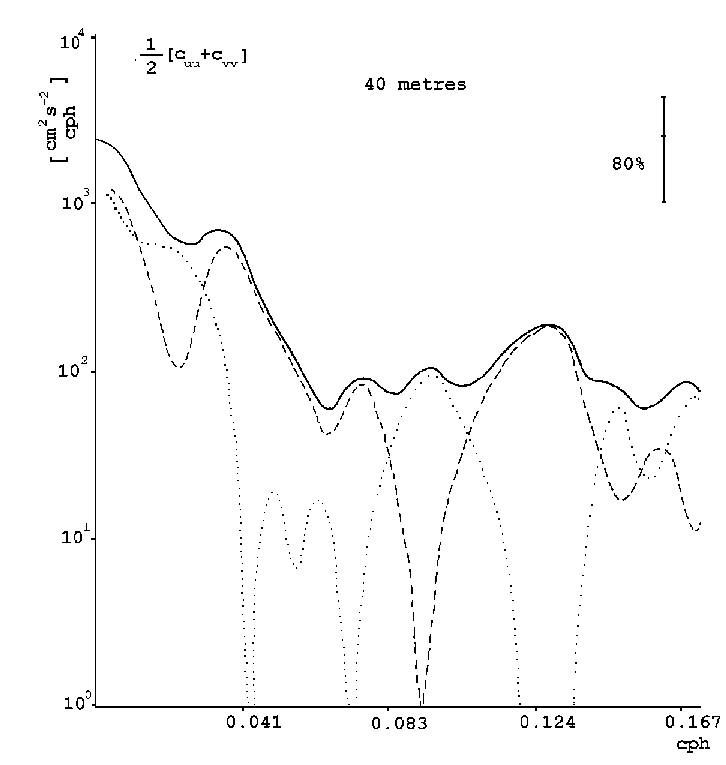
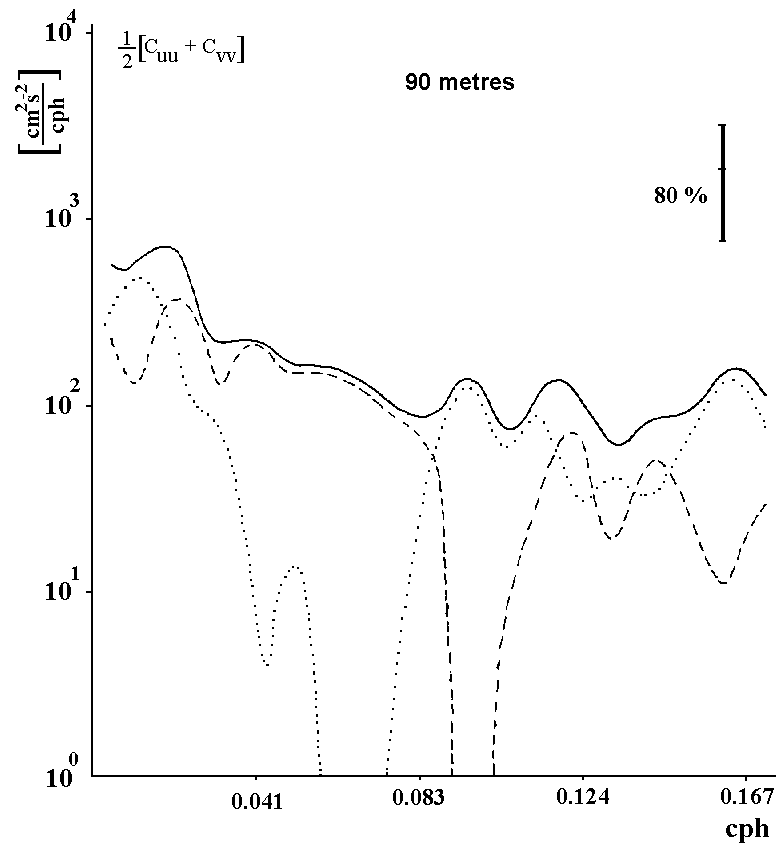
Concluding remarks
The circulation rotary spectra produced for the u (east-west) and v (north-south) components show a dominant typically diurnal, semidiurnal, Ter-diurnal and fourth-diurnal counter-clockwise (and few clockwise) bands of tidal currents and other circulation spectral bands not specifically covered by this account. The non tidal spectral bands, of the circulation of PST, which barely passed the 95 % significance interval, have smaller amplitudes, such as the ones in the interval 1.3 to 1.6 cy/day (15 to 18 hours) with a counter-clockwise at 5 m layer and with a clockwise at 40 m and 2.3 to 2.7 cy/day (10.4 to 8.8 hours) with clockwise circulation. The low frequency circulation band 0.15 to 0.4 cy/day (2.5 to 6 days) of PST has a mainly anticlockwise circulation in both depths. In PPR the low frequency band (not forming clear peaks), shows an equally valued clockwise and counter-clockwise circulation, except for 90 m layer (that has a clockwise and a counter-clockwise circulation in two close bands), which is the opposite to what was observed in PST and PRJ, at the same depths. The low frequency circulation band of 0.15 to 0.4 cy/day of all stations has been pointed out to be mainly associated with oceanographic and meteorological agents and it is supposed that this may be also the case for the bands of 1.3 to 1.6 cy/day and 2.3 to 2.7cy/day.
A general characteristic of the structure of the tidal currents is that the diurnal components of currents have greater amplitudes in the surface layers down to 40 m layer and tend to become smaller with depth. The semidiurnal currents, however, have approximately constant amplitudes along the vertical profile, fact also followed by M3 . semidiurnal heights constituents M2, N2 , K2, and S2 have an anticlockwise propagation from PRJ to PST and a clockwise one between PRJ and PST. Their amplitudes show a general increase from East to West, being higher near the port of Paranaguá. The higher values of tidal heights constituents not necessarily induce the higher values of currents components. At the bottom, the currents of PPR and PRJ seem to be following accordingly, i.e., higher values of currents components are associated with higher values of the corresponding components of tidal heights, as the diurnal amplitudes of currents decrease towards the bottom and the semi-diurnals and the Ter-diurnals tend to preserve their surfaces values along the depth.
Acknowledgements
We grateful to FINEP (Financiadora de Estudos e Projetos ) da Presidência da República of Brazil, to FAPESP (Fundação de Amparo a Pesquisa de Estado de São Paulo) and the British Counsil, UK.
References
Cartwright D E & Zetler B D. 1985. Pelagic Tidal Constants. IAPSO Scientific Publication No. 33. 1-53.
Emilson I . 1961. The Shelf and coastal waters off southern Brazil. Bolm. Inst. oceanogr. , S Paulo. 11 (2) : 101 - 112.
França, C. A. S. 1988. Estudo da Geração das Componentes da Maré de Pequeno Fundo na Costa Sudeste Brasileira. Dissertação de mestrado. Universidade de São Paulo, Instituto Oceanográfico. 159p.
Franco, A. S. & Rock, N. J. 1971. The fast Fourier transform and its application to tidal oscillation. Bolm Inst. oceanogr., S Paulo. SP.
Franco, A. S. dos & Mesquita, A. R. de 1986. On the practical use in Hidrography of Filtered daily values of mean sea level.Int. HIDRg. Rev. Monaco LXIII(2):133-141.
Gonella, J. 1972. A Rotary- component method for analysing meteorological and oceanographic vector time series. Deep Sea Res. , 19:833 - 846.
Harari, J. 1977. Modelo tridimensional da região costeira Centro Sul do Brasil. Dissertaçao de mestrado. Universidade de São Paulo. Instituto Oceanográfico. 118 p.
Harari, J. 1984. Modelo hidrodinâmico tri-dimensional linear da plataforma continental Sudeste do Brasil. Tese de doutorado. Universidade de São Paulo. Instituto Astronômico e Geofísico. 203 p.
Harari, J. 1991. Modelo hidrodinâmico tridimensional do Oceano Atlântico Sul. Tese de livre-docência. Universidade de São Paulo..Instituto Oceanográfico. 350p.
Hutnance, J. M. 1980. On shelf "resonance" with application to Brazilian M3 tides. Deep - Sea research, Vol. 27 A: 347-366.
Jenkins, G. M. & Watts, D. G. 1968. Spectral Analysis and its applications. Holden- Day. San Francisco London, Panama Toronto. 523p.
Johannessen, O. M. 1968. Note on some hydrographical and current observations from three positions on the Brazilian shelf in the region of Cabo Frio - Santos 1966. Contrções Inst. oceanogr. Univ. S Paulo, ser. oceanogr. fis., 10:1-8.
Leite, J. B. A. 1983. Estudos da variação temporal de temperatura e salinidade do sistema de correntes e sua estabilidade numa área de ressurgência. Dissertação de mestrado. Universidade de São Paulo. Instituto Oceanográfico. 178 p.
Mesquita, A. R. de; Leite, J. B. A.; Weber, R. R. & Tupinambá, P. M. 1976a. Variabilidade dos parâmetros físicos durante a realização da Estação 3.099 do N/Oc. "Prof. W. Besnard": Cruzeiro 78. Relat. de cruz. N/Oc. "Prof. W. Besnard". Inst.oceanogr. Univ. S Paulo, (1):1-13.
Mesquita, A. R. de; Souza, J. M. C.; Leite, J. B. de A. & Festa, M. 1976b. Variabilidade dos parâmetros físico químicos durante a realização da estação 3.144 do N/Oc. "Prof. W. Besnard": Cruzerio 80. Relat. cruz. N/Oc. "Prof. W. Besrnard". Inst oceanogr. Univ. S Paulo,. SP. (2):1-28.
Mesquita, A. R. de; Souza, J. M. C.; Tupinambá, P. M.; Weber, R. R.; Festa, M. & Leite, J. B. A. 1977. Correntes rotatórias e variabilidade do campo de massa na plataforma do estado de São Paulo (Ponto: 25(S; 46(W). Relat Cruzeiros sér N/Oc. "Prof. W. Besnard". Inst. oceanogr. Univ. S. Paulo. SP 3:1-37.
Mesquita, A. R. de; Leite, J. B. de A. & Rizzo, R. 1989. Patterns of Instability in a Region of Shelf Break Upwelling. Proc. SIUEC (1982: Nov. 21 - 27: Rio Grande, RS. Brazil). Vol. 2 :425-436.
Mesquita, A. R. de; Leite, J. B. A. & Rizzo, R. 1983. A Note on the shelf Break Upwelling off the Southeast coast of Brazil (Lat. 216(50´S ; Long 33(05´W) Bolm Inst. oceanogr., S Paulo, 32 (2):193-198.
Mesquita, A. R. de & Harari, J. 1983. Tides and Tide auges of Cananéia and Ubatuba. Relat. int. Inst.oceanogr. Univ. S Paulo, (11):1-14.
Mesquita, A. R. de & Leite, J. B. A. 1986. Sobre a Variabilidade do Nível Médio do Mar na costa Sudeste do Brasil. Rev. bras. de Geofis., (4 ):229-
Mesquita, A. R. de 1983. Contribuição à Oceanografia da Região Costeira Sudeste do Brasil (Lat 24(S) - Sub Projeto Hidrodinâmica Costeira : Execução e Resultados. Tese de livre-docência. Universidade de São Paulo, Instituto Oceanográfico. 187p.
Mesquita, A. R. de 1994. Variação do Nível Médio do Mar de Longo Termo . Inst. est. avanc. Univ. S Paulo. SP. Documentos-Série Ciências Ambientais.Vol(20):47-67.
Munk, W. H. & Cartwright, D. E. 1966. Tidal Spectroscopy and prediction. Phil. trans. Roy. Soc., Ser. A, Mathematical and Physical Sciences. N. 1105, Vol. (259 ):533 - 581.
Smithson, M. J. 1992. Pelagic Tidal Constants. IAPSO (International association for the Physical Sciences of the Oceans o the IUGG) 33:1 191.
Spencer, R. & Gwiliam, T. J. P. 1974. Sea bed capsule for measuring pressure at depths up to 4000 metres. Proc., of IEEE. Inter. conf. Ing In the Ocean Environmet. Vol. (1): 339 - 343.